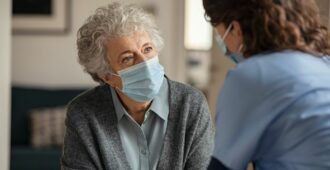
When the 45 and Up Study launched in 2005, one of its core aims was to understand more about why people get cancer and how we can help them. Eighteen years later, the Study has been used by leading cancer researchers whose work has shed light on risk factors, diagnosis, screening, patterns of care, health system costs, burden of disease and more.
With more than a quarter of a million participants at initial recruitment, the 45 and Up Study is one of the largest in the world. But it’s not just the size of the Study that matters. The long-term support it has received from Cancer Council NSW has been critical to its success in cancer research.
Here are five recent studies that have had a significant impact on how we think about cancer:
Evidence supports lung cancer screening in Australia
Research published last year strengthened the case for a targeted lung cancer screening program in Australia. This research from the Daffodil Centre, a joint venture between Cancer Council NSW and the University of Sydney, found that screening could reduce lung cancer deaths by up to 24%, without placing an excessive financial burden on the health system. Researchers used the 45 and Up Study to determine the proportion of Australians eligible for low-dose CT scans to detect lung cancer.
These findings added to the years of research into lung cancer done by the Daffodil Centre and Cancer Council NSW using 45 and Up Study data, which was detailed in the December 2022 issue of Public Health Research & Practice. Earlier research on the accuracy of lung cancer risk prediction algorithms informed the 2020 government enquiry into lung cancer screening, which supported a targeted screening program. In May, the federal government announced an investment of $263 million into a national lung cancer screening program, which will begin in 2025.
Lung cancer is currently the deadliest cancer, killing 8,500 Australians a year, but survival rates significantly improve if the cancer is detected in its early stages.
Cancer risks from light drinking revealed
Landmark research that tracked the health of 45 and Up Study participants found that even ‘light drinking’ of seven alcoholic drinks a week raises the risk of alcohol-linked cancers by 10%, compared to people who consumed less than one alcoholic drink a week.
Researchers from Cancer Council NSW (who are now with the Daffodil Centre) and Australian National University analysed five years of data. The results, published in 2020 in the British Journal of Cancer, showed that seven types of cancer were linked to alcohol consumption – liver, oesophagus, mouth, pharynx, larynx, bowel and breast cancers.
The strongest association was with liver cancer: people consuming 7-14 drinks a week had a 48% increase in the relative risk of liver cancer compared with less than one drink a week, while those drinking more than 14 drinks had a 202% increase.
This research added to a growing body of evidence on alcohol increasing the risk of certain cancers. Later in 2020, the national alcohol guidelines were amended so that the maximum recommended alcohol intake was lowered from 14 to 10 drinks per week.
Surgery and radiotherapy choices in prostate cancer
Prostate cancer is the most frequently diagnosed cancer in Australian men, but for many years it’s been unclear who is receiving which types of treatment for the cancer and why. Research published in 2021 using the 45 and Up Study found that men with localised prostate cancer are much more likely to receive surgery over radiotherapy, despite the latter being less invasive and having a similar survival rate.
This research, which analysed data from 4,000 men, also revealed that only one in seven patients were referred to a radiation oncologist, and that those with private health insurance were more likely to receive invasive surgery. Patients who lived in areas of greater socio-economic disadvantage or further than 100 kilometres from a radiotherapy centre were less likely to have radiotherapy.
These findings have been used in medical education programs, which help more patients get the right treatment for them.
Even one cigarette a day is harmful
Research by the Daffodil Centre shed light on the impact of light smoking on Australians. Drawing on long-term data from participants of the 45 and Up Study, researchers found that people who smoked one to five cigarettes per day were nine times more likely to develop lung cancer compared to people who had never smoked, and 38 times more likely if they smoked more than 35 cigarettes per day.
The insights from this research, which were published in 2021, led to improved front-line advice on quitting as well as guidelines for doctors.
Life after cancer shown to be just as good for many
With improved detection and treatment, many cancer survivors are living well. Research led by the Australian National University examined cancer survivors from the 45 and Up Study, comparing 22,000 people with cancer to 244,000 people without cancer.
Survivors of melanoma, breast, prostate, and bowel cancers rated their quality of life almost as highly as those who never had cancer. However, people who had lung cancer, multiple myeloma and non-Hodgkin’s lymphoma rated their quality of life as poorer.
The findings, published in 2020, helped to reduce the stigma surrounding common cancers and pointed to priority areas for future research, care and support.





